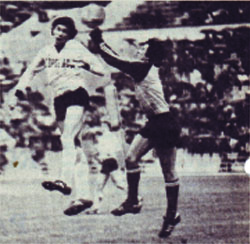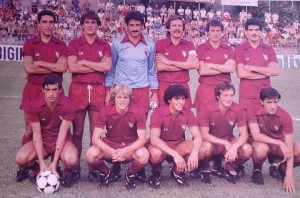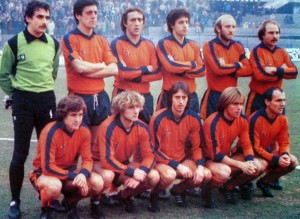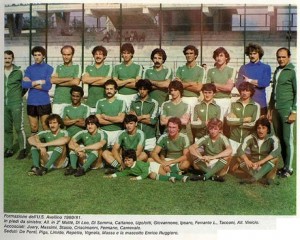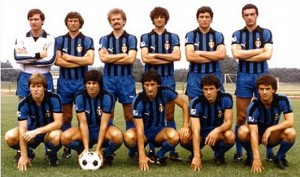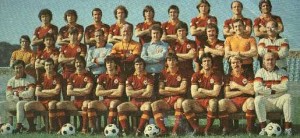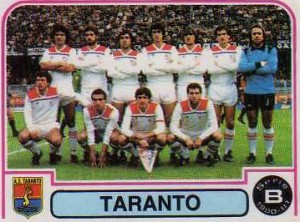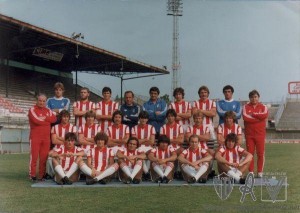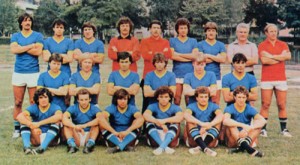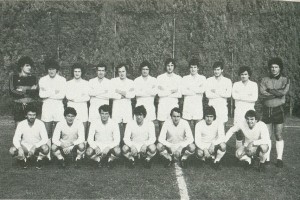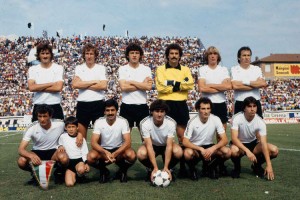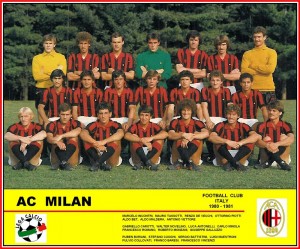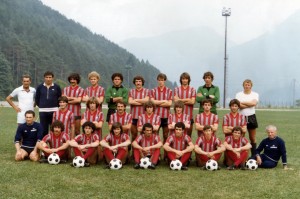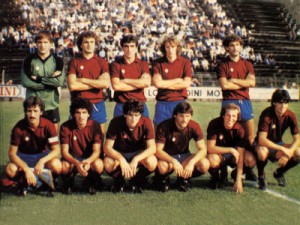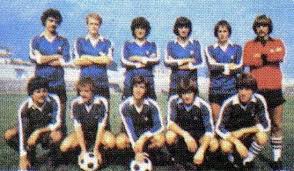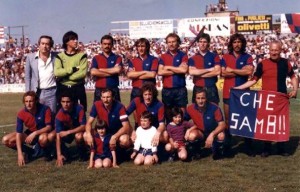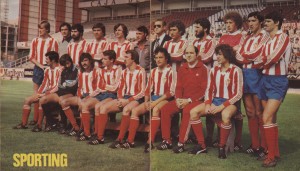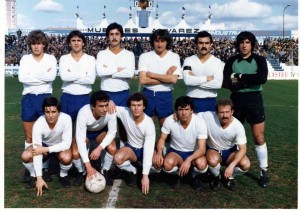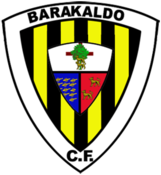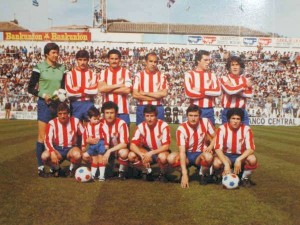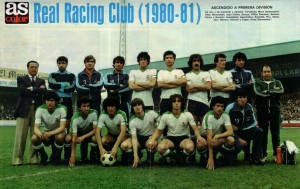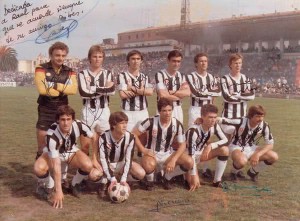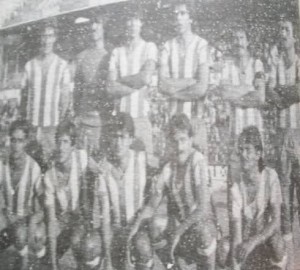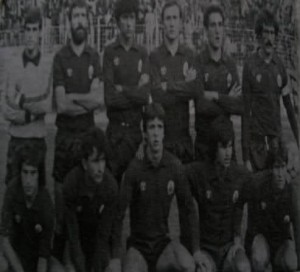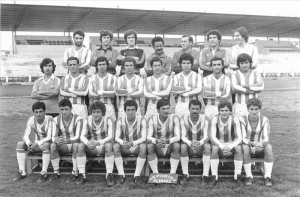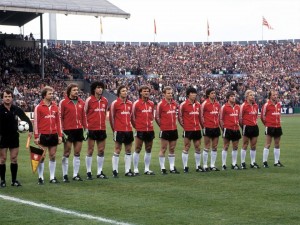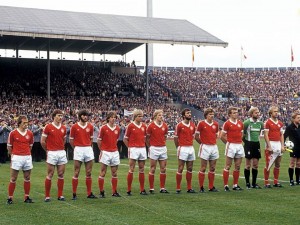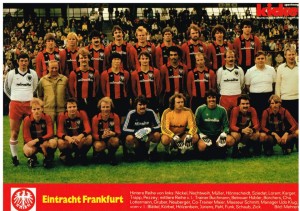Dramatic as it was the Segunda Division, it was nothing compared to the Primera Division’s season. Technically, 6 teams competed for the title, but effectively they were three, dropping to two in the last few rounds and the champion became known only in the last round, bringing surprise, joy, and bitter disappointment all at once. Marvelous battle at the top, not so at the bottom. The outsiders became known early and accepted their fate, which made life easier for those having hard time, like Las Palmas , 15th, and Real Zaragoza, 14th. They had comfortable advantage and eventually Las Palmas finished 5 points ahead of the relegation zone.
 Real Murcia finished 16th with 23 points, the best of the outsiders.
Real Murcia finished 16th with 23 points, the best of the outsiders.
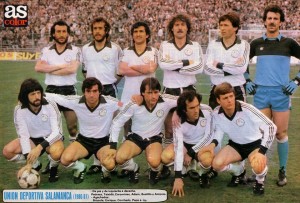 UD Salamanca took the 17th place, distinguishing itself with the leakier defense this season.
UD Salamanca took the 17th place, distinguishing itself with the leakier defense this season.
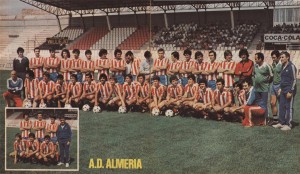 AD Almeria was last with 19 points, 2 points behind Salamanca, and the most lost matches in the league – 21. These three clubs were relegated and nothing surprising about that – they all were all prime candidates for the last places.
AD Almeria was last with 19 points, 2 points behind Salamanca, and the most lost matches in the league – 21. These three clubs were relegated and nothing surprising about that – they all were all prime candidates for the last places.
Up the table – nothing really knew or unusual, most teams finishing as expected.
 Even Las Palmas, measly 16th this year, was not exactly a sign of decay – they were never in danger and, if having weak season, they still belonged to the bulk of middle-of-the-road clubs occupying most positions in the league.
Even Las Palmas, measly 16th this year, was not exactly a sign of decay – they were never in danger and, if having weak season, they still belonged to the bulk of middle-of-the-road clubs occupying most positions in the league.
The real battle raged at the very top and had a bit of a bitter twang.
 Real Betis finished 6th with 40 points. Standing from left: Esnaola, Bizcocho, Biosca, Ortega, Peruena, Gordillo.
Real Betis finished 6th with 40 points. Standing from left: Esnaola, Bizcocho, Biosca, Ortega, Peruena, Gordillo.
First row: Morán, López, Diarte, Cardeñosa, Benítez.
An up and down club, which had a strong year this time, but finished perhaps disappointed – one point behind Barcelona and 2 points short of a place giving a spot in the UEFA Cup. Unlucky, yes, but really they were the weakest team among the best.
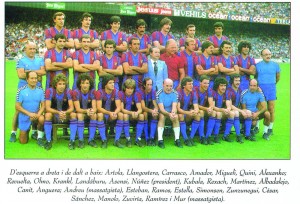 Barcelona finished 5th, a terrible season for them, for they were never really in the race for the title – staying close, that was all. Yes, Barcelona ended just 4 points behind the champions and shared the best scoring record in the league with Real Madrid, but the plain fact was Barca was out. There was important change in the squad – Hans Krankl, pictured here, was still a nominal member of the team, but Barcelona bought the new European sensation Bernd Schuster, who immediately was a starter, The great Austrian scorer was already on his way out – he was loaned to lowly First Vienna the previous season and clearly his days with Barcelona were over. Getting Schuster was the right move, but it was hardly enough – the team had too many problems: aging stars, like Asensi, Rexach, Migueli, not enough class in the next generation, and going for years goalkeeping problem, still unsolved – Artola was pushing 30, but he was never a very good keeper – and still the first choice. However, good or bad, Barcelona is a kind of club looking only for results – 5th place was a disaster.
Barcelona finished 5th, a terrible season for them, for they were never really in the race for the title – staying close, that was all. Yes, Barcelona ended just 4 points behind the champions and shared the best scoring record in the league with Real Madrid, but the plain fact was Barca was out. There was important change in the squad – Hans Krankl, pictured here, was still a nominal member of the team, but Barcelona bought the new European sensation Bernd Schuster, who immediately was a starter, The great Austrian scorer was already on his way out – he was loaned to lowly First Vienna the previous season and clearly his days with Barcelona were over. Getting Schuster was the right move, but it was hardly enough – the team had too many problems: aging stars, like Asensi, Rexach, Migueli, not enough class in the next generation, and going for years goalkeeping problem, still unsolved – Artola was pushing 30, but he was never a very good keeper – and still the first choice. However, good or bad, Barcelona is a kind of club looking only for results – 5th place was a disaster.
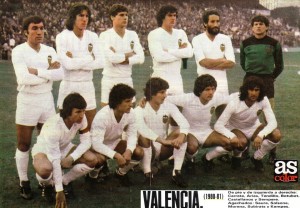 With 42 points, Valencia took the 4th place. This was their best team in a decade, and at its prime too, but, let’s face it, it was a bit short of a true winner. It depended on Mario Kempes, who, unfortunately, was starting to go down – perhaps his peak was at 1978-79. The addition of the Uruguayan great star Fernando Morena was a bit of a disappointment, if not outright mistake. Valencia was strong, but not a title contender. Yet, they finished with better record than Atletico Madrid and took 4th place only because in Spain, when teams finished with equal points, the direct matches between the rivals were the decisive factor.
With 42 points, Valencia took the 4th place. This was their best team in a decade, and at its prime too, but, let’s face it, it was a bit short of a true winner. It depended on Mario Kempes, who, unfortunately, was starting to go down – perhaps his peak was at 1978-79. The addition of the Uruguayan great star Fernando Morena was a bit of a disappointment, if not outright mistake. Valencia was strong, but not a title contender. Yet, they finished with better record than Atletico Madrid and took 4th place only because in Spain, when teams finished with equal points, the direct matches between the rivals were the decisive factor.
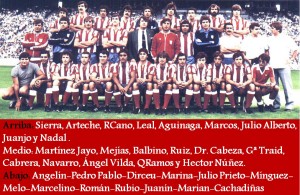 If there was a table of the most disappointed, Atletico Madrid should have taken the first place – but they had only to blame themselves. Atletico was on top of the table 26 rounds. They lost the first place just 4 rounds before the end of the championship and in the remaining rounds went out of the race, dropping to 3rd position, at the end keeping it only because they played well against Valencia, their direct rival at this point. No stamina… perhaps the training plan was wrong, because just at the end other teams were at their best and Atletico was losing steam. Compared to others – not a bad team, seemingly re-built at last. The best Brazilian midfielder at the 1978 World Cup – Dirceu – joined the team, after playing in Mexico, and the controversial striker Ruben Cano was also here. But instead of a title, they were lucky to get bronze.
If there was a table of the most disappointed, Atletico Madrid should have taken the first place – but they had only to blame themselves. Atletico was on top of the table 26 rounds. They lost the first place just 4 rounds before the end of the championship and in the remaining rounds went out of the race, dropping to 3rd position, at the end keeping it only because they played well against Valencia, their direct rival at this point. No stamina… perhaps the training plan was wrong, because just at the end other teams were at their best and Atletico was losing steam. Compared to others – not a bad team, seemingly re-built at last. The best Brazilian midfielder at the 1978 World Cup – Dirceu – joined the team, after playing in Mexico, and the controversial striker Ruben Cano was also here. But instead of a title, they were lucky to get bronze.
Atletico’s exit from the race for the title only intensified the battle – at the end and to the very last minute of the championship, it was between Real Madrid and Real Sociedad. Both teams were a bit out of the picture for the most of the season – one can find them as low as 10th – Real Sociedad – and 9th – Real Madird – at some stages of the championship, but they really stepped on the pedal at the end, when mattered most. Real Sociedad took the first place in the 31st round and never lost it – curiously, Real Madrid was not first ever this season. Their big chance came in the very last round – Real had to win and Sociedad had to lose – Madrid promptly won their match, meantime Sociedad was luckily losing. But it was no good to bet on somebody else’s misfortune – Sociedad equalized and both rivals finished with 45 points each. Which benefited the opposition. Real Madrid finished 2nd.
 What a disappointment – most points, most wins, the best attack, the best goal-difference… and second. Compared to Barcelona, Atletico Madrid, and Valencia, Real had stronger and better rounded squad: good goalkeeper with massive experience – Garcia Remon, excellent leader of defense – Camacho, one of the best central defenders in Europe, a great motor, roving back and forth, and organizing everything – Stielike, already moving to the position of libero, and, arguably, the best attack in Spain – Santillana, Juanito, and Cunningham. May be stronger than the opposition, but still it was not a dream team… and paid the heavy price for not playing its best for a good chunk of the season. Unlucky, yes – but…
What a disappointment – most points, most wins, the best attack, the best goal-difference… and second. Compared to Barcelona, Atletico Madrid, and Valencia, Real had stronger and better rounded squad: good goalkeeper with massive experience – Garcia Remon, excellent leader of defense – Camacho, one of the best central defenders in Europe, a great motor, roving back and forth, and organizing everything – Stielike, already moving to the position of libero, and, arguably, the best attack in Spain – Santillana, Juanito, and Cunningham. May be stronger than the opposition, but still it was not a dream team… and paid the heavy price for not playing its best for a good chunk of the season. Unlucky, yes – but…
But in the last minute Real Madrid lost the title and Spain had brand new champion, a new name added to the list – Real Sociedad. They needed just a point before the last round, but face a very difficult match: visiting Sporting Gijon. Gijon was tough cookie anyway and those were strong years for club – they finished 7th in the championship and reached the Cup final. Near the end of the last match Gijon was leading 2-1. And on top of everything, the weather was difficult – it was raining. 10 minutes before the end of the match Real Madrid was getting ready to be once again champion… and then Zamora equalized. Real Sociedad kept the tie to the final whistle and after it their joy had no limits.
 Modest Real Sociedad from San Sebastian was the surprise and unlikely champion of Spain. Who would expect it? Surely Real Sociedad was noticed a few years earlier as having new exciting team, climbing up, but champions? Until the 31st round their best position in the table was 2nd place, which had twice – they were 2nd after the 20th round and then once again in the 30th. But moved up after the 31st round and maintained their top position to the very end. One may argue they were lucky, because Atletico Madrid lost steam at that time, but the argument would be lame: Real Sociedad was obviously in good form and at the end of the season they were at their best. One may argue that they were not the best this year, because Real Madrid ended with better record. May be so, but Real Sociedad delivered when mattered most – their decisive game early in March, when they hosted Real Madrid and beat them 3-1. This secured a small, yet, very important lead – the first match in the fall Real Madrid won, but only 1-0. Thus, in the last round Real Sociedad needed only a tie, which they extracted from difficult Sporting Gijon. Simple calculations, not so simple to apply, but there was something else in favour of the new champions: when nobody was looking they assembled a very good squad, lead by three young bright stars – Arkonada, Zamora, and Lopez Ufarte. Why the big clubs did not snatch them is a mystery, yet, a costly one, because in 1980-81 Real Sociead emerged with star players for the future – unlike the aging stars Barcelona and Real Madrid had. This was a big opportunity not just for the club, but for Spanish football as a whole, for now, when the boys were champions, there was no way the club would sell them – on the contrary, Real Sociedad had every reason to add more strong players to its squad, thus enlarging the group of strong Spanish clubs and making the coming championships more interesting and challenging. Lucky victory perhaps, but very welcoming one.
Modest Real Sociedad from San Sebastian was the surprise and unlikely champion of Spain. Who would expect it? Surely Real Sociedad was noticed a few years earlier as having new exciting team, climbing up, but champions? Until the 31st round their best position in the table was 2nd place, which had twice – they were 2nd after the 20th round and then once again in the 30th. But moved up after the 31st round and maintained their top position to the very end. One may argue they were lucky, because Atletico Madrid lost steam at that time, but the argument would be lame: Real Sociedad was obviously in good form and at the end of the season they were at their best. One may argue that they were not the best this year, because Real Madrid ended with better record. May be so, but Real Sociedad delivered when mattered most – their decisive game early in March, when they hosted Real Madrid and beat them 3-1. This secured a small, yet, very important lead – the first match in the fall Real Madrid won, but only 1-0. Thus, in the last round Real Sociedad needed only a tie, which they extracted from difficult Sporting Gijon. Simple calculations, not so simple to apply, but there was something else in favour of the new champions: when nobody was looking they assembled a very good squad, lead by three young bright stars – Arkonada, Zamora, and Lopez Ufarte. Why the big clubs did not snatch them is a mystery, yet, a costly one, because in 1980-81 Real Sociead emerged with star players for the future – unlike the aging stars Barcelona and Real Madrid had. This was a big opportunity not just for the club, but for Spanish football as a whole, for now, when the boys were champions, there was no way the club would sell them – on the contrary, Real Sociedad had every reason to add more strong players to its squad, thus enlarging the group of strong Spanish clubs and making the coming championships more interesting and challenging. Lucky victory perhaps, but very welcoming one.
 And one more look at the squad winning the title for the first time in the history of Real Sociedad. A wonderful ending of dramatic championship – not every year a country has a new champion, especially Spain.
And one more look at the squad winning the title for the first time in the history of Real Sociedad. A wonderful ending of dramatic championship – not every year a country has a new champion, especially Spain.
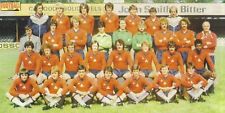 York City finished last, 24th with 33 points. Not that it mattered – nobody was relegated from the lowest professional division. The team was dead last only for the record.
York City finished last, 24th with 33 points. Not that it mattered – nobody was relegated from the lowest professional division. The team was dead last only for the record. Hereford United – a typical member of 4th Division: a bad season this time, 22nd at the end, but may be next year – a bit up. Or not. What mattered here was at the top – the teams trying to get promotion. The top 4 were blessed with that and Peterborough United missed the boat – 5th with 52 points.
Hereford United – a typical member of 4th Division: a bad season this time, 22nd at the end, but may be next year – a bit up. Or not. What mattered here was at the top – the teams trying to get promotion. The top 4 were blessed with that and Peterborough United missed the boat – 5th with 52 points. Doncaster Rovers bested Wimbledon, but was far behind the teams competing for the league title. Enough for promotion, but almost 10 points behind the 2nd placed team.
Doncaster Rovers bested Wimbledon, but was far behind the teams competing for the league title. Enough for promotion, but almost 10 points behind the 2nd placed team. Lincoln City finished 2nd with 65 points and the best defense in the league. They lost the title, though – by 2 points.
Lincoln City finished 2nd with 65 points and the best defense in the league. They lost the title, though – by 2 points.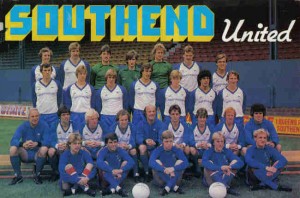 And the champions were Southend United with 67 points. Well done. There are clubs, which could be champions of lower leagues only. Nothing wrong with that, wonderful and successful season. Going up – what could be better?
And the champions were Southend United with 67 points. Well done. There are clubs, which could be champions of lower leagues only. Nothing wrong with that, wonderful and successful season. Going up – what could be better?